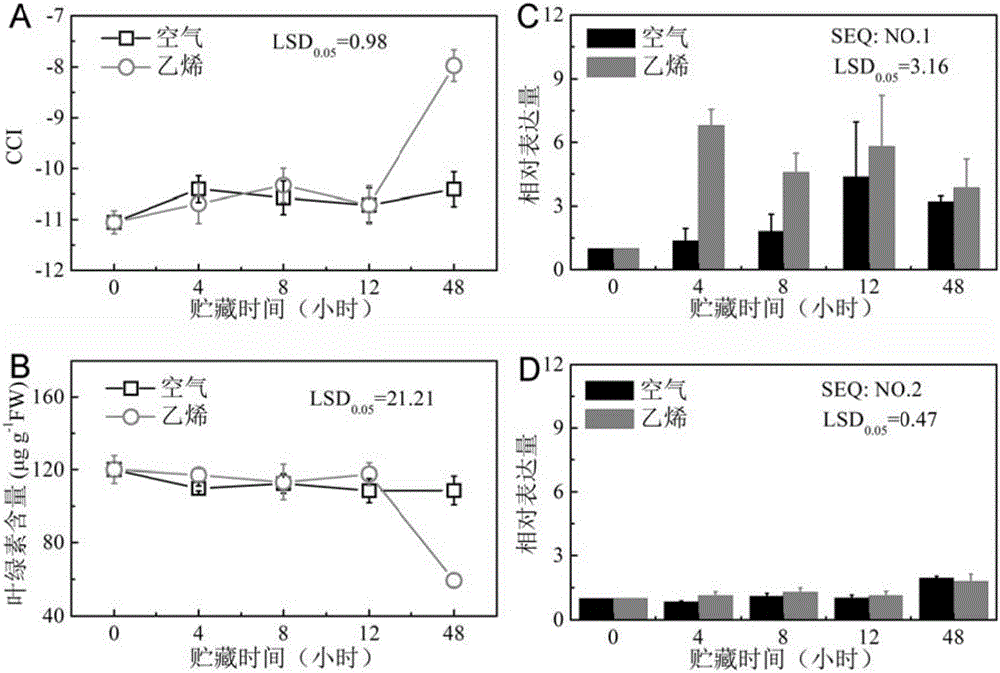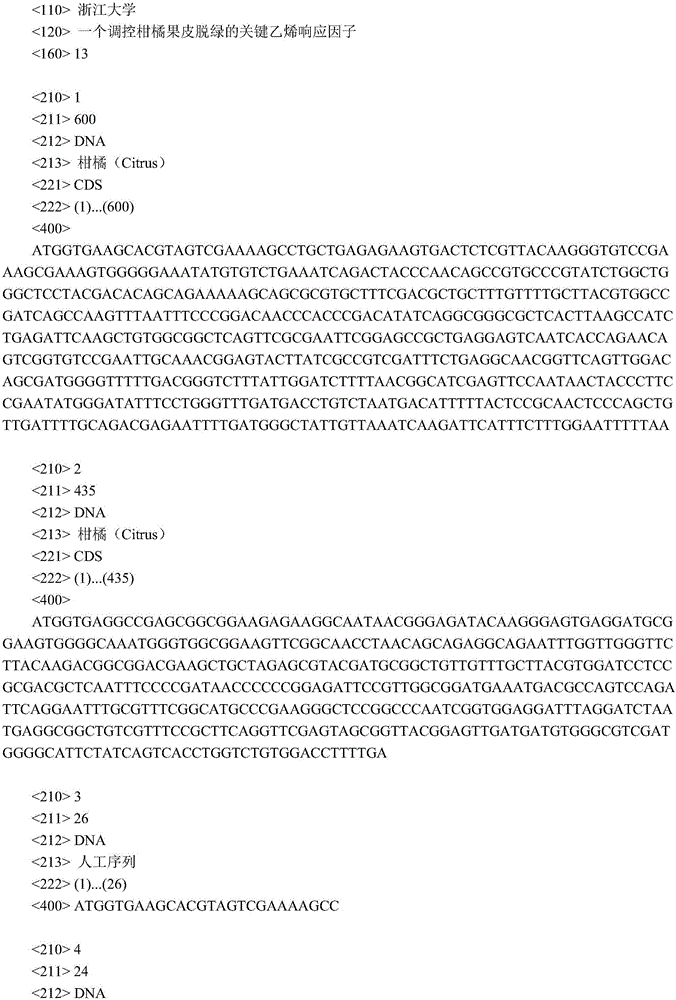Key ethylene response factor for regulating chlorophyll degradation of citrus peels
A technology of citrus peels and response factors, which can be used in applications, genetic engineering, plant genetic improvement, etc., and can solve problems such as unclear biological mechanisms
- Summary
- Abstract
- Description
- Claims
- Application Information
AI Technical Summary
Problems solved by technology
Method used
Image
Examples
Embodiment 1
[0025] Example 1: Gene Cloning
[0026] CitAP2 / ERF gene family members were obtained based on the Citrus Sweet Orange and Clementine Genome Database (http: / / www.citrusgenomedb.org). On the one hand, directly download the genes that may belong to AP2 / ERF according to the annotations, on the other hand, perform BLAST (TBLASTN and BLASTP) analysis on the reported Arabidopsis AP2 / ERF genes, and use the sequences obtained in these two ways to use AP2 / ERF The conserved domains were screened one by one, and then the CAP3 sequence assembly program (http: / / pbil.univ-lyon1.fr / cap3.php) was used to remove repetitive sequences to obtain CitERF6 (SEQ: NO.1) and CitERF8 (SEQ: NO. .2).
[0027] Combining the primer pair SEQ: NO.3 and SEQ: NO.4, and SEQ: NO.5 and SEQ: NO.6, use PCR technology to amplify the two genes obtained respectively, wherein the 30 μl PCR system is: 10×Buffer 3 μl , dNTP 2.4 μl, upstream / downstream primers 0.6 μl each, enzyme 0.15 μl, DEPC-H 2 O 21.3 μl, 50 mM MgSO ...
Embodiment 2
[0028] Example 2: Gene expression analysis
[0029] (1) Experimental method
[0030] 1. Fruit material collection
[0031]The navel orange fruits 150 days after the full flowering period arrived at the laboratory on the same day after harvest, and the fruits with uniform size and relatively consistent maturity were selected to carry out the experiment. The fruits were randomly divided into two groups (100 in each group), and each group was placed in 3 airtight containers on average, and one group was passed through 40 μL·L -1 Ethylene gas for 12 hours, while the other group was ventilated with air for 12 hours, and then transferred to a shelf and placed in an environment of 20°C. Samples were taken at 0, 4, 8, 12 and 48 hours respectively. Nine fruits were taken each time and divided into three biological replicates.
[0032] 2. Determination of the color index (CCI) of citrus peel: it is determined by the color difference meter MiniScan XE Plus (HunterLab, USA), and the c...
Embodiment 3
[0040] Example 3: Verification of gene function
[0041] (1) Experimental method
[0042] 1. Construction of recombinant vector
[0043] Primers (SEQ: NO.3 and SEQ: NO.4) were designed according to the verified full-length sequence of CitERF6 (SEQ: NO.1) to amplify its open reading frame. Using the cDNA of citrus peel as a template, slightly modified the high-fidelity enzyme system of Roche Company, and prepared a PCR system with a final volume of 30 μl: 10×Buffer 3 μl, dNTP 2.4 μl, upstream / downstream primers 0.6 μl, enzyme 0.15 μl, DEPC-H 2 O2 1.3 μl, 50 mM MgSO 4 1.2 μl, cDNA 0.75 μl. The reaction conditions were: pre-denaturation at 95°C for 5 min; denaturation at 95°C for 10 sec, annealing at 58°C for 5 sec, extension at 72°C for 2.5 min, and 35 thermal cycles; extension at 72°C for 10 min, and storage at 4°C. After the PCR product was recovered, it was connected to the pGEM-T easy vector, and the recombinant plasmid was introduced into E. coli DH5α competent cells, ...
PUM
 Login to View More
Login to View More Abstract
Description
Claims
Application Information
 Login to View More
Login to View More - R&D
- Intellectual Property
- Life Sciences
- Materials
- Tech Scout
- Unparalleled Data Quality
- Higher Quality Content
- 60% Fewer Hallucinations
Browse by: Latest US Patents, China's latest patents, Technical Efficacy Thesaurus, Application Domain, Technology Topic, Popular Technical Reports.
© 2025 PatSnap. All rights reserved.Legal|Privacy policy|Modern Slavery Act Transparency Statement|Sitemap|About US| Contact US: help@patsnap.com



